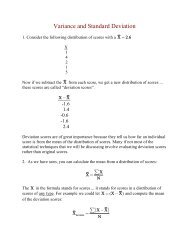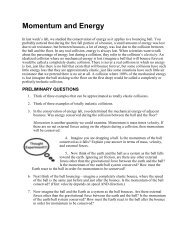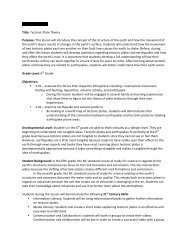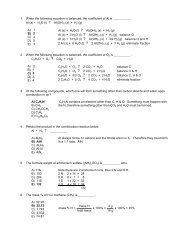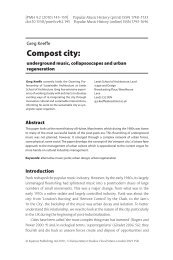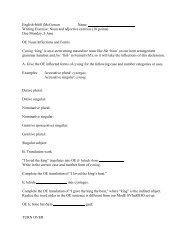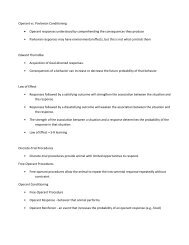1. How many grams of Cl2 can be prepared from the reaction of ...
1. How many grams of Cl2 can be prepared from the reaction of ...
1. How many grams of Cl2 can be prepared from the reaction of ...
Create successful ePaper yourself
Turn your PDF publications into a flip-book with our unique Google optimized e-Paper software.
6. Which <strong>of</strong> <strong>the</strong> following contains <strong>the</strong> greatest num<strong>be</strong>r <strong>of</strong> atoms?A. 100 g <strong>of</strong> Pb MW = 207, so this is ~ ½ mol.B. 2.0 mole <strong>of</strong> Ar this is 2 mol.C. 0.1 mole <strong>of</strong> Fe this is 0.1 mol.D. 5 g <strong>of</strong> He MW = 4, so this is ~ 1¼ mol.E. 20 million O 2 molecules this is a tiny fraction <strong>of</strong> a mole7. <strong>How</strong> <strong>many</strong> atoms are <strong>the</strong>re in <strong>1.</strong>00 ng <strong>of</strong> magnesium? (1 g = 1 x 10 9 ng)A. 4.11 x 10 -11 atomsB. 2.48 x 10 13 atomsC. 6.83 x 10 -35 atomsD. 6.02 x 10 14 atomsE. <strong>1.</strong>46 x 10 34 atoms9<strong>1.</strong>0 x10g 1mol.Mg 6.02 x10atoms<strong>1.</strong>00 ng x x x= 2.48 x101ng 24.3 g Mg 1mol.2313atoms8. What is <strong>the</strong> coefficient <strong>of</strong> H 2 O when <strong>the</strong> following equation is properly balanced with smallest set <strong>of</strong> whole num<strong>be</strong>rs?_1_ Al 4 C 3 + _12_ H 2 O → _4_ Al(OH) 3 + _3_ CH 4A. 3B. 4C. 6D. 12E. 249. <strong>How</strong> <strong>many</strong> moles <strong>of</strong> oxygen atoms are contained in 10 moles <strong>of</strong> KClO 3 (potassium chlorate)?A. 3 molB. 3.3 molC. 10 molD. 30 molE. 6.02 x 10 24 mol10 mol. KClO3 mol. Ox1mol. KClO3 =330 mol. O10. Identify <strong>the</strong> major ionic species present in an aqueous solution <strong>of</strong> Na 2 CO 3 .A. Na 2 + CO 32-B. Na 2 + , C 2- O 3C. Na + , C 4+ , O 32-D. Na + , C + , O 2-E. Na + , CO 32-1<strong>1.</strong> The distinguishing characteristic <strong>of</strong> all electrolyte solutions is that <strong>the</strong>yA. contain molecules.B. conduct electricity. (that is why it is called electrolyte)C. react with o<strong>the</strong>r solutions.D. always contain acids.E. conduct heat.
12. In accordance with <strong>the</strong> solubility rules, which <strong>of</strong> <strong>the</strong> following is true when solutions containing about 0.1 g <strong>of</strong>Pb(NO 3 ) 2 (aq) and 100 mL <strong>of</strong> 0.200 M KI(aq) are mixed?Pb(NO 3 ) 2 (aq) + 2KI(aq) → PbI 2 (s) + 2KNO 3 (aq)A. KNO 3 will precipitate; Pb 2+ and I - are spectator ions.B. No precipitate will form.C. Pb(NO 3 ) 2 will precipitate; K + and I - are spectator ions.D. PbI 2 will precipitate; K + and NO - 3 are spectator ions.E. Pb 2+ and I - are spectator ions, and PbI 2 will precipitate.13. In accordance with <strong>the</strong> solubility rules, which <strong>of</strong> <strong>the</strong> following is true when solutions <strong>of</strong> CuSO 4 (aq) and BaCl 2 (aq) aremixed?CuSO 4 (aq) + BaCl 2 (aq) → CuCl 2 (aq) + BaSO 4 (s)A. CuCl 2 will precipitate, and Ba 2+ and SO 2- 4 are spectator ions.B. CuSO 4 will precipitate, and Ba 2+ and Cl - are spectator ions.C. BaSO 4 will precipitate, and Cu 2+ and Cl - are spectator ions.D. BaCl 2 will precipitate, and Cu 2+ and SO 2- 4 are spectator ions.E. No precipitate will form.14. The common constituent in all acid solutions isA. H 2B. H + This is <strong>the</strong> Bronsted definition <strong>of</strong> an acidC. OH -D. H 2 SO 4E. Cl -15. Which is <strong>the</strong> chemical formula <strong>of</strong> <strong>the</strong> salt produced by neutralization <strong>of</strong> nitric acid with calcium hydroxide?2HNO 3 + Ca(OH) 2 → Ca(NO 3 ) 2 + H 2 OA. CaNO 3B. Ca 2 (NO 2 ) 3C. Ca(NO 2 ) 2D. Ca 2 NO 3E. Ca(NO 3 ) 216. The oxidation num<strong>be</strong>r <strong>of</strong> S in K 2 SO 4 isA. +6B. +4C. +2D. -1E. none <strong>of</strong> <strong>the</strong>m(2 x K) + S + (4 x O) = 0(2 x +1) + S + (4 x -2) = 0S = 617. The oxidation num<strong>be</strong>r <strong>of</strong> Fe in K 3 Fe(CN) 6 isA. +3B. +2C. +1D. -3E. -4(3 x K) + Fe + (6 x CN - ) = 0 (it is important to recall that CN has a -1 charge)(3 x +1) + Fe + (6 x -1) = 0Fe = 3
18. Which one <strong>of</strong> <strong>the</strong> following is a redox <strong>reaction</strong>?A. H + (aq) + OH - (aq) → H 2 O(l)B. 2KBr(aq) + Pb(NO 3 ) 2 (aq) → 2KNO 3 (aq) + PbBr 2 (s)C. CaBr 2 (aq) + H 2 SO 4 (aq) → CaSO 4 (s) + 2HBr(g)D. 2Al(s) + 3H 2 SO 4 (aq) → Al 2 (SO 4 ) 3 (aq) + 3H 2 (g) Al 0 → Al 3+ and H + → H 0E. CO 2- 3 + HSO - 4 → HCO - 2-3 + SO 419. In <strong>the</strong> following <strong>reaction</strong> <strong>the</strong> oxidizing agent is5S + 6KNO 3 + 2CaCO 3 → 3K 2 SO 4 + 2CaSO 4 + CO 2 + 3N 2A. S S 0 → S 6+ S is oxidized, thus it is <strong>the</strong> reducing agentB. N 2 N 2 is a productC. KNO 3 N 5+ → N 0 N is reduced, thus <strong>the</strong> KNO 3 must <strong>be</strong> <strong>the</strong> oxidizing agentD. CaSO 4E. CaCO 320. What element is oxidized in <strong>the</strong> following <strong>reaction</strong>?Cd + NiO 2 + 2H 2 O → Cd(OH) 2 + Ni(OH) 2A. Cd Cd 0 → Cd 2+B. NiC. OD. H2<strong>1.</strong> When 0.860 g <strong>of</strong> an organic compound containing C, H, and O was burned completely in oxygen, <strong>1.</strong>64 g <strong>of</strong> CO 2 and<strong>1.</strong>01 g <strong>of</strong> H 2 O were produced. What is <strong>the</strong> empirical formula <strong>of</strong> <strong>the</strong> compound?1mol.CO 2 1mol. C0.0373 mol.A. CHOC : <strong>1.</strong>64 g CO 2 xx = 0.0373 mol. C= 2 mol.C44.0 g CO 2 1mol.CO 20.0189 mol.B. CH 2 OC. C 2 H 4 O1mol. H 2O2 mol. H0.111mol.H : <strong>1.</strong>01g H 2 O x x= 0.111mol. H= 6 mol. HD. C 2 H 6 O18.0 g H 2O1mol. H 2O0.0189 mol.E. C 3 H 6 O 2 ⎛1mol.C ⎞ ⎛1mol.H ⎞O : 0.860 g sample -⎜0.0373 mol.C x - 0.111mol.H = 0.302 g O12.0 g C⎟⎜x<strong>1.</strong>01g H⎟⎝⎠ ⎝⎠1mol.O0.0189 mol.O : 0.302 g O x = 0.0189 mol.O= 1mol. O16.0 g O0.0189 mol.Thus C 2 H 6 O22. What is <strong>the</strong> mass percent <strong>of</strong> Cu in 10 g CuSO 4 ?A. 0.398%B. <strong>1.</strong>51%C. 2.51%D. 39.8%E. 66.1%g Cu63.5 gx100%=x100%= 39.8 %g Cu + g S + g O 63.5 g + 32.1g + 4(16.0) g


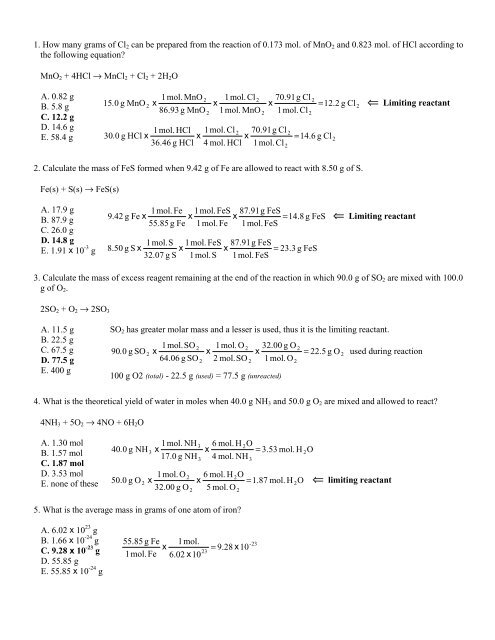
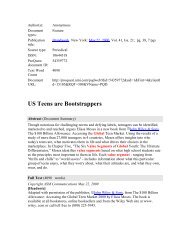

![Graduate Bulletin [PDF] - MFC home page - Appalachian State ...](https://img.yumpu.com/50706615/1/190x245/graduate-bulletin-pdf-mfc-home-page-appalachian-state-.jpg?quality=85)
